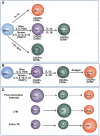Cell Differentiation Degree as a Factor Determining the Role for Different T-Helper Populations in Tuberculosis Protection
- PMID: 31134070
- PMCID: PMC6517507
- DOI: 10.3389/fimmu.2019.00972
Cell Differentiation Degree as a Factor Determining the Role for Different T-Helper Populations in Tuberculosis Protection
Abstract
Efficient tuberculosis (TB) control depends on early TB prediction and prevention. Solution to these tasks requires knowledge of TB protection correlates (TB CoPs), i.e., laboratory markers that are mechanistically involved in the protection and which allow to determine how well an individual is protected against TB or how efficient the candidate TB vaccine is. The search for TB CoPs has been largely focused on different T-helper populations, however, the data are controversial, and no reliable CoPs are still known. Here we discuss the role of different T-helper populations in TB protection focusing predominantly on Th17, "non-classical" Th1 (Th1*) and "classical" Th1 (cTh1) populations. We analyze how these populations differ besides their effector activity and suggest the hypothesis that: (i) links the protective potential of Th17, Th1*, and cTh1 to their differentiation degree and plasticity; (ii) implies different roles of these populations in response to vaccination, latent TB infection (LTBI), and active TB. One of the clinically relevant outcomes of this hypothesis is that over-stimulating T cells during vaccination and biasing T cell response toward the preferential generation of Th1 are not beneficial. The review sheds new light on the problem of TB CoPs and will help develop better strategies for TB control.
Keywords: Th1; Th17; correlates of protection; non-classical Th1; tuberculosis.
Figures

References
-
- Global Tuberculosis Report 2018 World Health Organization. Available online at: http://apps.who.int/iris/bitstream/handle/10665/274453/9789241565646-eng.... (accessed Dec 23, 2018).
Publication types
MeSH terms
LinkOut - more resources
Full Text Sources
Other Literature Sources
Medical

